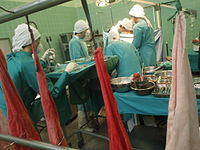
Photo from wikipedia
Human leukocyte antigen (HLA)-matched donors for hematopoietic stem cell transplantation (HSCT) have long been scarce in China. Haploidentical (haplo) donors are available for the vast majority of patients, but toxicity… Click to show full abstract
Human leukocyte antigen (HLA)-matched donors for hematopoietic stem cell transplantation (HSCT) have long been scarce in China. Haploidentical (haplo) donors are available for the vast majority of patients, but toxicity has limited this approach. Three new approaches for haplo-HSCT originated from Italy, China, and USA in 1990 and have been developed to world-renowned system up to now. The Chinese approach have been greatly improved by implementing new individualized conditioning regimens, donor selection based on non-HLA systems, risk-directed strategies for graft-versus-host disease and relapse, and infection management. Haplo-HSCT has exhibited similar efficacy to HLA-matched HSCT and has gradually become the predominant donor source and the first alternative donor choice for allo-HSCT in China. Registry-based analyses and multicenter studies adhering to international standards facilitated the transformation of the unique Chinese experience into an inspiration for the refinement of global practice. This review will focus on how the new era in which “everyone has a donor” will become a reality in China.
Journal Title: Frontiers of Medicine
Year Published: 2018
Link to full text (if available)
Share on Social Media: Sign Up to like & get
recommendations!